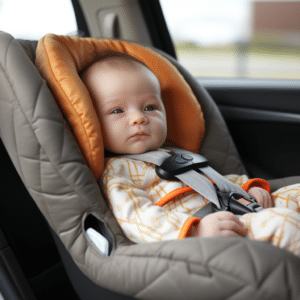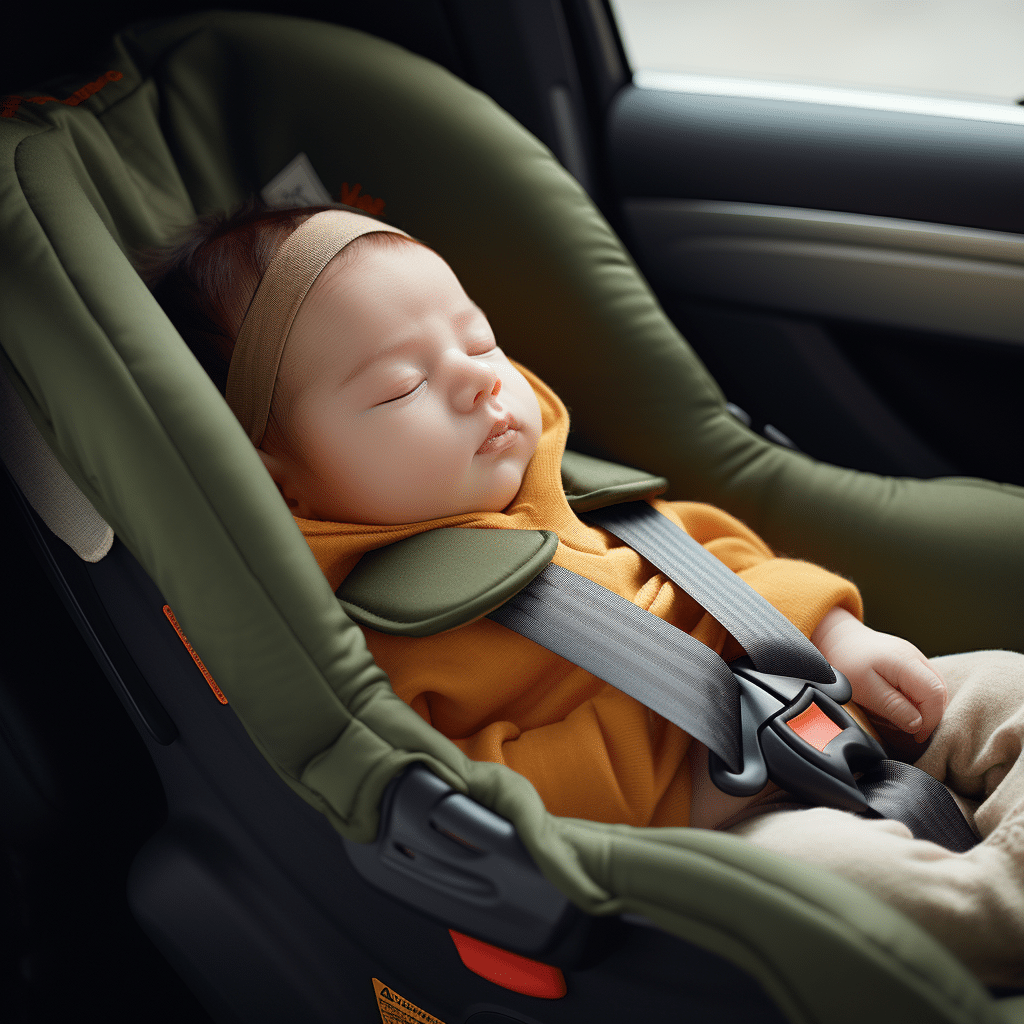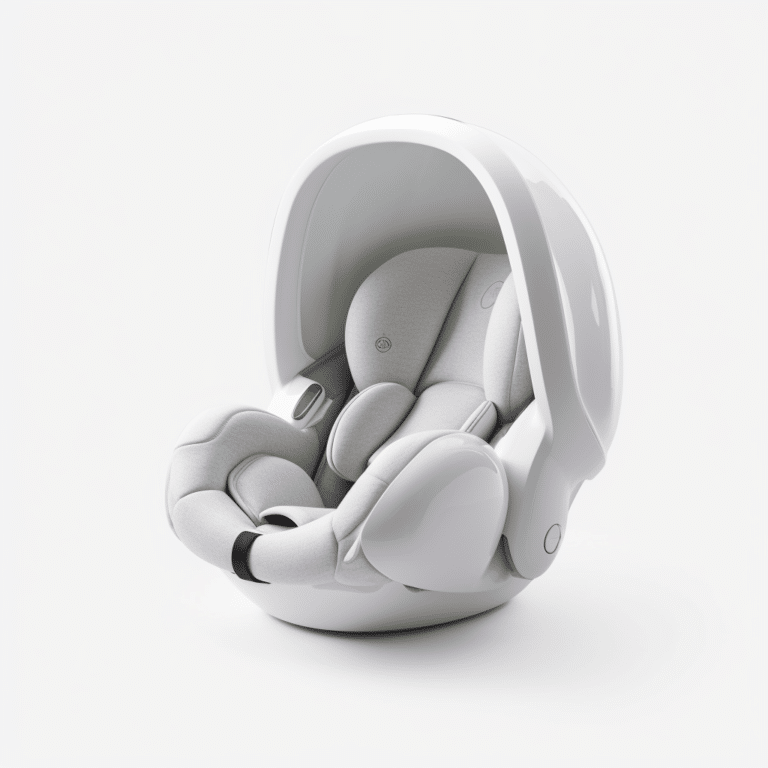Protecting Newborns: Proper Car Seat Positioning Matters
Introduction: Understanding the Importance of Proper Positioning in Car Seats
Dangers of Neck Injuries for Newborns in Car Seats: Car seat positioning is vital for protecting newborns. Knowing its importance and fitting car seats properly can prevent neck strain and discomfort.
To get a snug fit, check the harness and adjust it to the child’s body. Also, select a car seat that fits your baby’s size and age exactly.
For maximum comfort, set the recline angle to around 45 degrees. This semi-reclined position helps their airways stay open and unrestricted.
Pro Tip: During long trips, regularly check your baby’s posture in the car seat. Even small changes can make a big difference in keeping them safe.

The Dangers of Neck Injuries for Newborns in Car Seats
Neck injuries pose significant risks to newborns when they are secured in car seats. These dangers can arise due to the improper positioning of the head and neck, leading to strains, sprains, or even more severe conditions. The neck, being delicate and Dangers of Neck Injuries for Newborns in Car Seats vulnerable at such a young age, requires special attention and care in the context of car seat safety. It is crucial to understand the potential harm that can occur and take appropriate measures to prevent such injuries.
Car seats provide essential protection for infants during transportation, ensuring their safety in the event of a collision. However, if the infant’s head and neck are not properly supported, it can result in the so-called “newborn in car seat neck” condition, where the neck muscles and ligaments may experience strain or damage. This situation can be exacerbated by factors such as a too reclined or slouched position, inadequate head support, or improper harnessing. Newborns lack the neck strength and control necessary to maintain proper alignment on their own, making them particularly vulnerable to these injuries.
In addition to the mentioned risks, it is worth noting that prolonged periods spent in car seats can further increase the chances of a newborn developing neck injuries. While it is necessary to use car seats for safe transportation, it is advisable to limit the time spent in them when not traveling.
A heart-wrenching incident serves as a powerful reminder of the potential consequences of neglecting proper car seat positioning. In this case, a newborn suffered severe strain in their neck muscles due to an incorrectly adjusted car seat. Thankfully, medical intervention and timely treatment allowed for a full recovery. However, this incident highlights the importance of adhering to car seat safety guidelines and diligently ensuring the correct positioning of a newborn’s head and neck.
As parents and caregivers, it is crucial to prioritize the safety and well-being of newborns, especially in the context of car seat usage. By understanding and addressing the dangers of neck injuries and taking appropriate precautions, we can ensure that our little ones are protected and free from harm during their journeys.
Strap in folks, we’re about to take a darkly hilarious journey into the inner workings of neck injuries in car seats – it’s a real head-turner.
Exploring the Mechanics of Neck Injuries in Car Seats
Car seats are essential for baby safety while travelling. But, it’s important to understand neck injuries that can happen. So, how to keep newborns safe? We must look at the dangers and find ways to prevent them.
One cause of neck injuries is lack of head support. Babies have weak neck muscles, making them more vulnerable if their heads flop during sudden stops or turns. Their weight plus the force can lead to strains, or worse.
To reduce this risk, parents should:
- Use newborn-specific car seats with extra padding and head/neck support.
- Adjust harness straps snugly around the baby’s shoulders.
- Place rolled blankets/towels on either side of the baby’s head.
- Avoid using aftermarket accessories, unless specifically designed and approved by the car seat manufacturer. These can compromise safety features and increase risk of injury.
Tips for Ensuring Proper Neck Support for Newborns in Car Seats
Ensuring Proper Neck Support for Newborns in Car Seats
Proper neck support for newborns in car seats is crucial to ensure their safety and comfort during travel. Here’s a 5-step guide to help you achieve this:
- Choose a suitable car seat: Opt for a car seat that is specifically designed for newborns, with adjustable head and neck support features.
- Position the car seat correctly: Install the car seat at a reclined angle to prevent your newborn’s head from falling forward. Make sure the car seat is securely and tightly installed.
- Use additional support: Consider using additional support accessories like head and neck cushions to provide extra support and prevent unnecessary movement.
- Adjust the straps properly: Ensure that the car seat straps are correctly positioned and snugly secured around your newborn’s shoulders, chest, and hips. Loose straps can lead to insufficient neck support.
- Take frequent breaks: During long car journeys, make regular stops to allow your newborn to stretch and move around. This can help prevent stiffness and discomfort.
It’s important to note that newborns have delicate neck muscles and structures. By following these tips, you can safeguard their neck and provide them with a more comfortable experience in car seats.
Pro Tip: Regularly check the car seat’s fit and adjust the support features as your newborn grows to ensure ongoing proper neck support.
Choosing the right car seat for newborns is like picking the perfect diaper – it’s all about containment and avoiding any messy disasters.
Choosing the Right Car Seat for Newborns
When it comes to car rides with newborns, picking the perfect car seat is essential. Not only does it provide the ideal neck support, but also a secure and snug fit! Check out these 6 points when choosing a car seat for your baby:
- Weight and Height: Choose one that fits your baby’s size and can grow with them.
- Rear-Facing: This offers the best protection for your infant and reduces the risk of neck injuries in case of accidents.
- Five-Point Harness System: Look for straps over each shoulder, hip, and between the legs. This ensures proper restraint and reduces the risk of ejection during collisions.
- Easy Installation: Choose one that you can easily install every time for optimal safety.
- Safety Standards: Look for certifications like NHTSA or JPMA to guarantee quality.
- Adjustable Features: Features like headrests, reclining positions, and harness height settings allow customization for comfort and growth.
Plus, keep an eye out for other details such as padding thickness, ease of cleaning, and compatibility with your vehicle. Fun fact – the concept of infant car seats originated in the 1930s, but back then they were mainly designed to keep babies from moving around. Over the years, car seat technology has come a long way in terms of safety and neck support.
Remember, picking the right car seat is key for your newborn’s safety and comfort on the road. You may now make a well-informed decision and provide your child the security they need thanks to the information provided above.
Adjusting the Car Seat Straps for Optimal Neck Support
Proper neck support is a must for newborns in car seats. To guarantee safety and comfort during travel, here’s a brief guide on how to adjust the straps correctly:
- Shoulder Straps: Place them at or below your baby’s shoulders. They should be snug but not too tight, so that your little one can move freely.
- Chest Clip: Fasten it at armpit level, making sure it rests on the breastbone without pinching or pressing. This distributes crash forces properly.
- Strap Tightness: Check by doing the pinch test. If you can pinch any slack, tighten until there’s none.
- Head Position: Make sure your baby’s head is supported against the back of the car seat with a slight downward inclination. This prevents it from flopping forward.
Remember: These steps are essential for optimal neck support. Newborns have weak neck muscles, so car rides require extra care. Follow these guidelines and adjust the straps correctly, for a safer journey.
A true story to support this: A friend of mine recently experienced how adjusting her son’s car seat saved him from harm. She was thankful his neck was secure and he didn’t suffer any whiplash-like effect due to improper support. Take this as a serious warning about the significance of using seat belts if you want to prevent neck injuries when driving.
Positioning newborns in car seats: Don’t let your little one become a contortionist!

Common Mistakes to Avoid when Positioning Newborns in Car Seats
Correct positioning of newborns in car seats is essential for their security and comfort while traveling. Here are some common mistakes to stay away from:
- Wrong angle for the seat: Check the manufacturer’s instructions and recline the car seat properly. This will stop your baby’s head from falling forward, blocking their breathing.
- Bulky clothing/blankets: Don’t dress your baby in thick layers or cover them with thick blankets while in the car seat. It can compress their chest and increase the risk of suffocation.
- Harness incorrectly placed: Make sure the straps are firmly on your newborn’s shoulders and fastened snugly. Loose straps can’t protect your baby if there are sudden movements or accidents.
- Failure to properly install a car seat: Make sure it’s set up properly in your car by checking it twice. It should not wobble or move a lot. A loose installation may damage the protection given by the car seat.
- Leaving baby alone: Never leave your newborn by themselves in the car seat, particularly outside of the car. They must always be watched and monitored for safety.
- Prolonged use of car seat: Use a car seat for traveling, yet don’t keep your baby in it for long when it’s not necessary. Prolonged confinement can lead to distress, limited movement, and even positional asphyxia.
For extra advice, consult a certified child passenger safety technician who can Dangers of Neck Injuries for Newborns in Car Seats provide personalized recommendations according to your specific needs and type of vehicle.
Keep in mind, making sure newborns are in the correct position in car seats is key for their wellbeing while travelling. By avoiding these common mistakes, you can increase their safety during road trips.
Pro Tip: Look at your car seat manufacturer’s website or sign up to safety newsletters frequently to stay up to date on any recalls or new guidelines. Safety standards can change over time, so it’s vital to stay informed for your baby’s sake.






